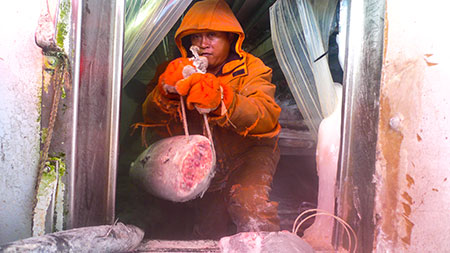Number 156 (May–August 2018)
Editorial
Climate change is usually associated with increasing temperatures and rising sea level. But these are only two of its many consequences, even if they are perhaps the most dramatic. Johann Bell and Tarûb Bahri, in their article on page 43, discuss the likely consequences of climate change for industrial and coastal fisheries of the Pacific Islands region, as well as for aquaculture. For industrial fisheries, it is predicted that the four main tuna stocks – albacore, bigeye, skipjack and yellowfin – will be ‘relatively’ unharmed by climate change because of their ability to move to favourable areas. But, this shift will particularly affect those small island States that are highly dependent on licence fees from industrial fleets, and in which the local population depends heavily on coastal marine resources for food security.
The consequences of climate change on small-scale fisheries are mostly linked to the increase in sea surface temperatures, which will drive many target species to higher latitudes, and will damage or destroy vast areas of reefs, thereby considerably reducing their productivity. In the Pacific islands, most small-scale catches come from coral reefs, and many communities have few sources of animal protein other than those derived from the sea, thus making coastal populations particularly vulnerable to climate change.
In reading the various articles in this issue, I couldn’t help but notice that almost all of the topics covered – tuna fisheries science and management, shark survival, identification of alternative marine resources, recruitment of juvenile eels, rock oyster aquaculture – cannot be addressed without taking into account the impact of climate change. A challenge that requires an urgent and effective response.
Aymeric Desurmont
Fisheries Information Specialist
In this issue
SPC ACTIVITIES
-
Cutting edge science at the 14th meeting of the WCPFC Scientific Committee (pdf: 202 KB)
-
Managing the world’s largest tuna fishery (pdf: 201 KB)
-
First workshop on harvest strategies for improved fisheries management (pdf: 84 KB)
-
Wallalis wobbling in whirly weather! A scientific mission thrown off course by heavy seas (pdf: 372 KB)
-
Tagging sharks to determine post-release mortality – the Pacific Shark Tagging Project (pdf: 425 KB)
-
Training in how to net the naughty people involved in coastal fisheries (pdf: 141 KB)
-
Institutional collaboration is key to regulating coastal fisheries in Kiribati (pdf: 134 KB)
-
Rock oyster Australian tour (pdf: 357 KB)
-
Increasing capacity of government and private sector shrimp hatchery technicians in Fiji (pdf: 151 KB)
-
Building the business skills of a tilapia farm operation in Papua New Guinea (pdf: 140 KB)
-
Alternative resources to supplement the Tongan deepwater snapper fishery (pdf: 182 KB)
-
Evaluation of the Pacific Islander Junior Professionals Programme (2013–2018) (pdf: 349 KB)
-
Customised leadership and management training for Pacific fisheries (pdf: 127 KB)
NEWS FROM IN AND AROUND THE REGION
-
Recruitment of freshwater eels as ‘glass eels’ in Fiji Islands – New research results about species composition and seasonality (pdf: 244 KB)
-
The Pacific Fisheries Officer Training Course – Where to from here? (pdf: 343 KB)
-
Revitalising the fish warden system in Fiji: Outcomes of the Second Northern Division Fish Warden Forum (pdf: 298 KB)
-
Small-scale tuna fishing at Kadavu Island, Fiji (pdf: 256 KB)
FEATURE ARTICLES
-
A new climate change vulnerability assessment for fisheries and aquaculture (pdf: 934 KB)



